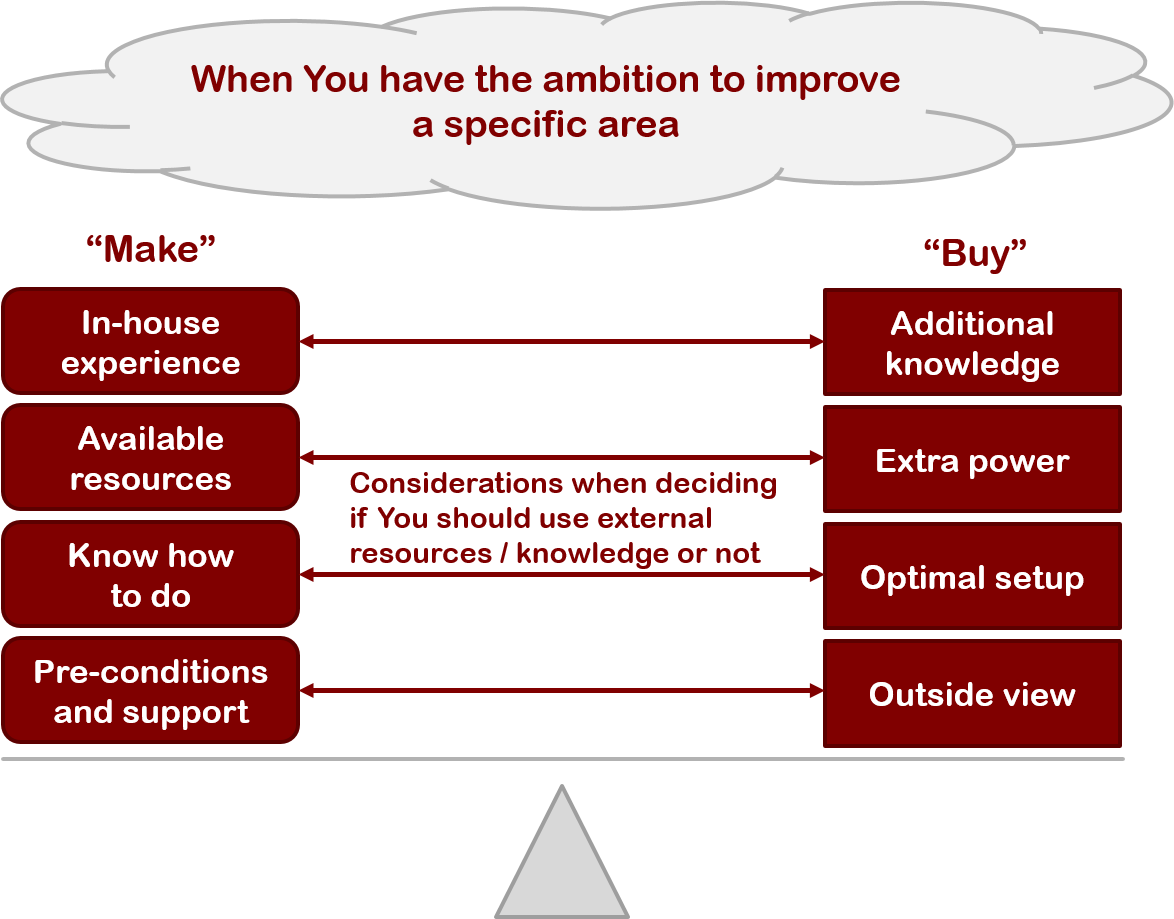"We support Customers avoiding risks when improving" |
Real life quotes:
“We have spent more than 6 MEuro during more than 10 years in developing our Telematics solution and we still are not getting any revenue from it.”
“Our new service portfolio, addressing the opportunities in the market better, is not used by more than half of the sales companies”
“We are performing 220000 Customer visits per year but after 10 years we are still only doing add-on sales in 10% of the potential cases”
“Our new selected service management solution has after 5 years been implemented in 3 markets”
What's Your focus?
Some Customer feedback:
Jiayu Zheng, Director Information management, Huawei: "We decided to complement our in-house expertise with additional outside experience from similar projects, so we bought knowledge from Balder Consulting"
Lars Andersen, Vice President Business Development Health Care, Getinge Infection Control: "As an important step in the development of our service business we contracted Balder Consulting"
Per Borgvall, CEO Gunnebo: "I hired Balder Consulting to investigate and suggest the way forward."
Frank Helf, Global AfterMarket Director, ArjoHuntleigh: "I have used Balder Consulting’s great report as a guide for the way forward supporting me delivering results"
What is Your industry?
Other messages:
From product to solution provider
The Top 10 Internet of Things risks
 Our ambition was to leverage on our contacts with service managers and make a small but structured study to analyse how improvement initiatives in the areas of Internet of Things or Service Growth are done and their view of the results. The reason we included both areas in the study was that both require changes in the front-line organisation both service and product sales as well as service delivery.
Our ambition was to leverage on our contacts with service managers and make a small but structured study to analyse how improvement initiatives in the areas of Internet of Things or Service Growth are done and their view of the results. The reason we included both areas in the study was that both require changes in the front-line organisation both service and product sales as well as service delivery.
We interviewed 20 service managers with consolidated organizations larger than 800 technicians and the study concluded that following 4 areas were the main reason for the improvements taking far too long time and/or not at all delivering as expected resulting in the loss of significant, irrecoverable, recurrent revenue.
- The improvement is not formalized into a project
- There are not enough allocated resources
- The improvement does not have the right pre-conditions
- No one has experience from previous similar improvement
When we summarized the study we realized that the issues relates back to the lack of experience from previous similar improvements.
Findings from the study
Generally, one finding is that service managers’ ability to aggressively develop in these areas are limited because they are totally filled up with operational activities.
 There is also hesitation in taking on bigger changes affecting many people in the subsidiaries mainly because of poor track record in previous big changes and the fact that the results will not show “in this year’s books”.
There is also hesitation in taking on bigger changes affecting many people in the subsidiaries mainly because of poor track record in previous big changes and the fact that the results will not show “in this year’s books”.
A bit more than half of the companies that we interviewed had been driving more organised growth initiatives either focusing on the service offerings or services sales in the past years. More of them had driven Internet of Things initiatives.
It was clear that there are very different ways of going about an improvement. There is a sliding scale from just agreeing that someone in the line organisation is responsible to improve something to actually setting up an improvement project, with clear targets, time and resource plan, steering group and progress reporting. The improvements, which we talked about in the interviews, were examples that positioned all over this sliding scale.
For the initiatives that have finished, the service managers perception was that they either took far longer time than expected (years) and/or did not meet the results expected. This is lost, irrecoverable, recurrent revenue.
Summary of the answers
When consolidating the information we got, the problems why so many change initiatives / projects failed fall into one of the following 4 areas:
 The new way of working solution and implementation experience: Many of the service managers in our study mentioned lack of company experience of similar projects as being a problem. They explained that this makes estimating the result of such an initiative difficult and designing and implementing the new way of working very complicated.
The new way of working solution and implementation experience: Many of the service managers in our study mentioned lack of company experience of similar projects as being a problem. They explained that this makes estimating the result of such an initiative difficult and designing and implementing the new way of working very complicated.
Resources required for the initiative: Something that we have noted throughout our years of working with service managers is that both themselves and their staff are usually fully occupied with caring for operational activities, e.g. responsibility for multiple units in different geographies, escalated emergencies, back-on-track activities, etc. This leaves few resources available for new improvement initiatives. Therefore, we are not surprised when this is mentioned as one of the main problems.
Setup of the initiative: The improvement when a number of service units are transformed from present situation to a “wanted position” is not formalized enough. There is no clear project, no well-defined target, no communicated time plan, no steering group supporting the change, no defined success measurement etc.
Preconditions and support for the initiative: Service managers tell us that they have problems acquiring adequate support from top management regarding the investment budget and support from their IT, HR and finance departments. Also, their subsidiaries do not prioritize change initiatives for service units. We noticed that these problems were stronger in the sales improvement cases versus IoT initiatives.
Our conclusion: The importance of experience
Our view is that all issues above are very much coming from the lack of previous experience and knowledge.
 Many of the improvement initiatives are “once in a life time”. You only activate your service technicians to sell once, you only make a global service offering portfolio once, you only enable connectivity and connect your Customers’ equipment once, you only make a Partner Service program once and you only implement these different changes once. These are unique “once in a life-time” changes any company will go through, so it is fair to say that for these kinds of changes, in-house experience is normally limited.
Many of the improvement initiatives are “once in a life time”. You only activate your service technicians to sell once, you only make a global service offering portfolio once, you only enable connectivity and connect your Customers’ equipment once, you only make a Partner Service program once and you only implement these different changes once. These are unique “once in a life-time” changes any company will go through, so it is fair to say that for these kinds of changes, in-house experience is normally limited.
Consider how it will look and feel like if:
- You know what targets to set and the time it will take – so you can make a real project of it.
- You know which design of the “new way of working” that will work best for your specific situation and you know which method of implementation that suits this particular change the best.
- You also know what pre-conditions that need to be there to succeed. You know that without them it is almost useless to start.
- You know what needs to be done so you can assign the right amount of resources.
You can make use of our experience
Do you have time to wait or do you want the growth as fast and predictable as possible? To temporarily buy that experience and resources will minimize the risk losing years of revenue and our fee represents just a fraction of such loss.
We have supported other companies and we can support you.
 If you are in front of an initiative or driving an initiative that doesn’t progress as you want we are representing an alternative for you. Instead of risking not meeting expectations we can support you with our resources and experience from similar projects to develop the best solution for your specific situation. We can also support you setting up the change project and improving the pre-conditions required for such a project to be successful. We have noticed that it is easier for an outsider to facilitate improved internal support (top mgmt., subsidiary mgmt., HR, IT etc.) because we are able to show good examples from other companies.
If you are in front of an initiative or driving an initiative that doesn’t progress as you want we are representing an alternative for you. Instead of risking not meeting expectations we can support you with our resources and experience from similar projects to develop the best solution for your specific situation. We can also support you setting up the change project and improving the pre-conditions required for such a project to be successful. We have noticed that it is easier for an outsider to facilitate improved internal support (top mgmt., subsidiary mgmt., HR, IT etc.) because we are able to show good examples from other companies.
Contact us so we can discuss how your opportunities could be addressed with a tailored solution
Get a real life revenue loss example and read about how we did the study